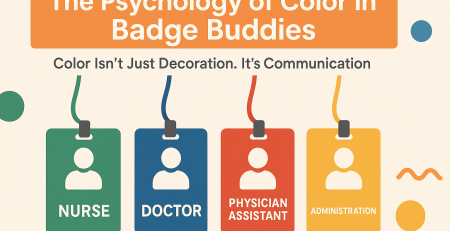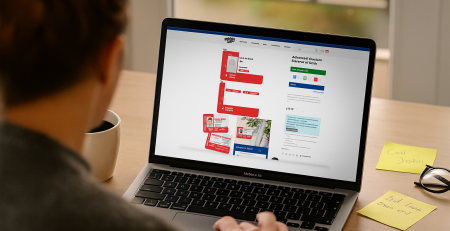Badge Buddy vs Standard ID: What’s the Real Difference?
Because Being Seen Shouldn’t Be a Struggle
Badge buddy vs ID badge — what’s the difference, and which one do you really need? If you’ve ever wondered whether a badge buddy or a traditional ID badge is better for your workplace, you’re not alone. In this quick guide, we’ll break down the pros, cons, and use cases of both. From hospital floors to event halls, the moment you clip on an ID badge, you’re saying, “This is who I am.”
But here’s the question — is anyone actually reading it?
That tiny print, muted color, or generic layout? It’s just not cutting it.
Enter the Badge Buddy:
the clarity booster that makes your role visible from across the room.
Let’s break down the differences between a standard ID badge and a Badge Buddy — and why one of them is seriously upgrading workplace communication.
1. Visibility: Go Bold or Get Missed
- Standard ID: Often features your photo, name, and department — all in small font, designed more for security than communication.
- Badge Buddy: Designed for immediate recognition. Large, high-contrast text like “RN” or “SECURITY” makes your role instantly obvious.
Why it matters: In fast-paced environments like hospitals or large events, no one has time to squint. Role clarity equals faster decisions, smoother workflows, and safer spaces.
2. Size and Layout: More Real Estate, More Impact
- Standard ID: Small vertical card with limited space. Usually cluttered with logos, barcodes, and required info.
- Badge Buddy: Sits behind the ID with its own canvas. Horizontal or vertical layouts allow room for bold titles, color-coding, and extra customization.
Why it matters: A Badge Buddy doesn’t replace your ID — it enhances it. It gives your role the real estate it deserves without compromising security protocols.
3. Color Coding: When Roles Speak in Color
- Standard ID: Mostly monotone or company-branded, with little role-based distinction.
- Badge Buddy: Built for instant differentiation. Blue = RN, Red = Security, Green = Admin, and so on.
Why it matters: In regulated industries like healthcare, color-coded roles aren’t just nice to have — they’re often required for compliance and safety.
If you work in an environment where quick visual identification matters — like hospitals or large events — a badge buddy is a must. On the other hand, a traditional ID badge may be all you need in office settings where access and identification are handled digitally.
Read the full Badge Buddy overview
4. Durability: Tough Enough to Work Overtime
- Standard ID: Usually printed on thin plastic or paper laminated cards. Easy to bend, scratch, or fade.
- Badge Buddy: Engineered for the grind. Multi-layer PVC, sealed edge-to-edge, waterproof, scratch-resistant, and ready for 16-hour shifts.
Why it matters: If your gear can’t survive your workday, it’s not helping you.
See full Badge Buddy breakdown
The Bottom Line: Not All ID Accessories Are Created Equal
A standard ID tells someone your name. A Badge Buddy tells them your role.
- Better visibility
- Faster recognition
- Safer environments
- Compliance with industry standards
Whether you choose a badge buddy or stick with an ID badge depends on your work environment. But if visibility and clarity are top priorities, badge buddies offer a simple, effective upgrade.
Then Badge Buddies aren’t just different — they’re better.
Ready to upgrade?
Customize yours now and show up clearly, confidently, and professionally.











